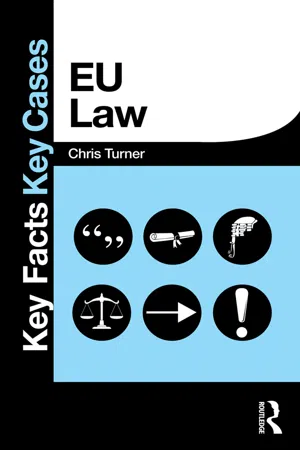
This is a test
- 280 pages
- English
- ePUB (mobile friendly)
- Available on iOS & Android
eBook - ePub
EU Law
Book details
Book preview
Table of contents
Citations
About This Book
Key Facts Key Cases: EU Law will ensure you grasp the main concepts of your EU Law module with ease. This book explains the facts and associated case law for:
-
- The constitution of EU law, its institutions, the sources of EU law and the means of enforcement
-
- The relationship with national law
-
- The law of the single market
-
- EU competition law
-
- EU discrimination law and other social policy
Key Facts Key Cases is the essential series for anyone studying law at LLB, postgraduate and conversion courses. The series provides the simplest and most effective way to absorb and retain all of the material essential for passing your exams. Each chapter includes:
-
- diagrams at the start of chapters to summarise key points
-
- structured headings and numbered points to allow for clear recall of the essential points
-
- charts and tables to break down more complex information
Chapters are also supported by a Key Cases section which provides the simplest and most effective way to absorb and memorise essential cases needed for exam success.
-
- Essential and leading cases are explained
-
- The style, layout and explanations are user friendly
-
- Cases are broken down into key components by use of a clear system of symbols for quick and easy visual recognition
Frequently asked questions
At the moment all of our mobile-responsive ePub books are available to download via the app. Most of our PDFs are also available to download and we're working on making the final remaining ones downloadable now. Learn more here.
Both plans give you full access to the library and all of Perlego’s features. The only differences are the price and subscription period: With the annual plan you’ll save around 30% compared to 12 months on the monthly plan.
We are an online textbook subscription service, where you can get access to an entire online library for less than the price of a single book per month. With over 1 million books across 1000+ topics, we’ve got you covered! Learn more here.
Look out for the read-aloud symbol on your next book to see if you can listen to it. The read-aloud tool reads text aloud for you, highlighting the text as it is being read. You can pause it, speed it up and slow it down. Learn more here.
Yes, you can access EU Law by Chris Turner in PDF and/or ePUB format, as well as other popular books in Law & Law Theory & Practice. We have over one million books available in our catalogue for you to explore.
1
The constitution and character of EU law

1.1.1 The concept of a single Europe
1 The UK tends towards ‘euro-scepticism’, so two misconceptions usually prevail:


2 The Roman Empire is one possible starting point, with several subsequent attempts at European unity or aspirations towards it:





3 So history possibly favours the ‘europhiles’, with ‘euro-scepticism’ a more recent nationalist hostility to the EU.
4 Ironically, a federal Europe originated as a British idea.
5 The intellectual architect of ‘Europe’ was Jean Monnet.
1.1.2 The background to the European Union (Community)
1 There were various attempts at integration in the 19th and 20th centuries.
2 These were based on need to avoid war, particularly after the Second World War.
3 There were two key factors:


4 Churchill, in his 1947 Zurich speech, said ‘We must build a kind of United States of Europe’.
5 The European Union of Federalists was established in 1947.
6 Continental advocates of union argued for ‘supranational bodies’ in the Montreux Resolution 1947.
7 Various intergovernmental agreements created new world or European organisations at this time: IMF; GATT; OEEC; The Council of Europe; Benelux Union.
1.1.3 The creation of the Treaties
1 The Treaties originated in the ‘Schumann Plan’ following principles established in the ‘Marshall Plan’ in the USA:


2 The plan led to the first Treaty: European Coal and Steel Community Treaty (ECSC Treaty) – Treaty of Paris 1951.


3 This was followed by an unsuccessful initiative to create a European Defence Community.
4 Further integration and a move towards the establishment of supranational institutions came with the two Treaties of Rome 1957 – the European Atomic Energy Community Treaty (EURATOM) and the European Economic Community Treaty (EC Treaty).
5 The latter resulted from the Spaak Committee Report and a recommendation for the creation of a ‘common market’.
6 The Treaties were originally signed by only six countries: France, Italy, Germany, Belgium, the Netherlands and Luxembourg.




Table of contents
- Cover
- Half Title
- Title Page
- Copyright Page
- Table of Contents
- Preface
- Table of Cases
- Chapter 1. The Constitution and Character of EU Law
- Chapter 2. The Institutions of the European Union
- Chapter 3. The Sources of European Law
- Chapter 4. Enforcement of EU Law
- Chapter 5. The Relationship between EU Law and National Law
- Chapter 6. Introduction to the Law of the Internal Market
- Chapter 7. Art 34 and Art 35 and the Free Movement of Goods
- Chapter 8. Art 30 and Customs Tariffs, and Art 110 and Discriminatory Taxation
- Chapter 9. Art 45 and the Free Movement of Workers
- Chapter 10. Art 49 and Freedom of Establishment; Art 56 and the Right to Provide Services
- Chapter 11. EU Competition Law
- Chapter 12. Art 157 and Anti-Discrimination Law
- Chapter 13. The Social Dimension
- Appendix
- Index